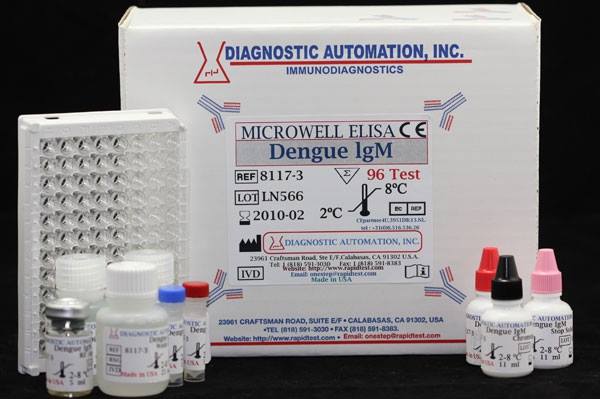Diagnosis of Dengue by IgM capture ELISA with principle, procedure and result interpretation
Diagnosis of Dengue by IgM capture ELISA with principle, procedure and result interpretation
Description of the test
Dengue IgM Capture ELISA is an enzyme linked immunosorbent assay for the qualitative detection of IgM antibodies against dengue virus antigen in human serum. Dengue IgM Capture ELISA is for the qualitative detection of anti-dengue IgM antibody with high degree of sensitivity and specificity. This test is used for the diagnosis of dengue virus infection.
Principle of the test
Dengue IgM Capture ELISA is a type of sandwich immunoassay. In this test, Dengue IgM negative control, Dengue IgM positive control and unknown serum samples are diluted with sample diluents, then incubated in microtitre well. If IgM antibodies are present in sample, it combines either mouse monoclonal anti-human IgM antibodies which is coated on well and then is bound to mixture of dengue antigen and mouse monoclonal anti-Dengue HRP Conjugate (MAb). After incubation, the micro wells are washed and a colorless substrate, tetramethylbenzidine (TMB) is added. Substrate is hydrolyzed by enzyme and the substrate changes to blue color. The enzyme activity found in the well will be directly proportional to the dengue IgM antibody concentration in patient serum. After adding the stop solution with acid the TMB becomes yellow. Color development is indicative of the presence of anti-dengue IgM antibody in the test sample.
Specimen collection
- Collect the whole blood by veinpuncture.
- Centrifuge whole blood to get serum. (Do not leave sera at room temperature for prolonged periods. Separated serum should remain at 20-25ºc for 8 hours. If test is not done within 8 hours, serum should be refrigerated at 2-8 ºc. For longer storage (more than 48 hours), serum should be frozen at or below -20 ºc.
Test Procedure
Precaution
Bring all kit reagents and sample to room temperature (25 ºc) before use. Thoroughly mix the reagents and samples before use. After washing the strips, the next reagents must be added immediately before the well become dry.
Protocol
- Take the required number of micro wells from the foil pouch. Number the strips as 1, 2, 3……
- Dilute Negative control, Positive control and Patient’s serum with sample diluent in 1:100 ratios.
Examples: 990µl of sample diluent +10µl of negative control/positive control/ samples. - Mix well.
- Prepare 1X wash buffer. (Dilute wash buffer concentrate to 1X with distilled water).
- Prepare Dengue antigen and Anti-Dengue HRP conjugate.
i. Dilute a bottle of antigen powder using 1500µl of the conjugate diluent.
ii. Mix it well.
iii. Dilute the Anti- Dengue HRP conjugate with diluted Dengue antigen in 1:1 ratio.
Example: 1.5ml of Anti-Dengue HRP conjugate+ 1.5ml of diluted Dengue antigen.
(NOTE: This is sufficient for 3 strips. Wrap it in aluminium foil).
iv. Mix it and leave at room temperature (15-30ºc) for 60 minutes. - Add 100µl of diluted controls and patient’s samples into their respective wells of micro-plate. Five micro-wells are required for negative control in triplicate positive control in duplicate.
- Cover the micro-plate with adhesive plate sealer.
- Incubate the plate at 37 ºc for 60 minutes.
- Wash the wells 5 times with 300µl diluted wash buffer. Tap the plate after last wash on a tissue paper.
- Transfer 100µl of diluted Anti-Dengue HRP conjugate solution into each wells of microplate.
- Cover the plate with adhesive plate sealer. Incubate the plate at 37 ºc for 60 minutes.
- Wash the wells 5 times with 300µl diluted wash buffer.
- Add 100µl of working TMB into each well.
- Cover with aluminium foil and incubate at room temperature for 10 minutes. The blue color will develop.
- Pipette 100µl of stopping solution into each well to stop the reaction. Blue color will changes to yellow.
- Within 30 minutes, read the absorbance of each well at 450nm with a reference filter of 620nm.
Interpretation of Results
Evaluation
Calculate the mean absorbance of negative controls, and then calculate the cut-off value by adding 0.300.
Average of negative control= x.
Cut-off= 0.3 +x.
Test results
- Sample < cut-off= anti-Dengue IgM negative
- Sample >cut-off= anti-Dengue IgM positive
Result interpretation
Negative results: No detectable IgM antibody.
Positive results: Presence of detectable IgM antibodies.
Diagnosis of Dengue by IgM capture ELISA with principle, procedure and result interpretation


Yes